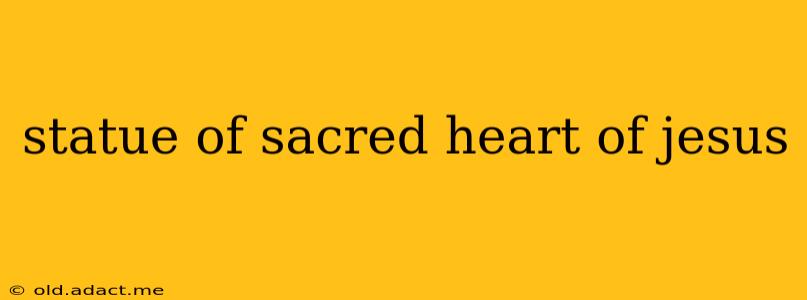The Sacred Heart of Jesus, a powerful image depicting the heart of Jesus Christ aflame with love, is a globally recognized symbol of devotion and piety within the Catholic faith. Millions worldwide venerate this image, finding solace, strength, and spiritual connection in its representation of divine love and compassion. But what exactly does the Sacred Heart represent, and what is the history behind its enduring popularity? This article explores the rich history, symbolism, and global impact of the Sacred Heart of Jesus, answering frequently asked questions surrounding this iconic image.
What does the Sacred Heart of Jesus symbolize?
The Sacred Heart of Jesus symbolizes the boundless, unconditional love of God for humanity. The burning flame signifies the intense, ever-present love of Christ, while the thorns represent the suffering he endured for our salvation. The image often incorporates a cross, further emphasizing the sacrifice made for humankind. Essentially, it’s a visual manifestation of Christ's compassion, mercy, and unwavering devotion to his followers. The symbolism goes beyond a simple depiction; it's a profound reminder of the sacrificial love at the heart of Christian faith.
What is the history of the devotion to the Sacred Heart?
Devotion to the Sacred Heart has a rich history, evolving over centuries. While earlier forms of devotion to Christ's heart existed, the modern devotion largely emerged in the 17th century, notably associated with Saint Margaret Mary Alacoque, a French Visitation nun. She claimed to have received revelations from Jesus, instructing her to promote devotion to His Sacred Heart. These revelations emphasized the immense love Jesus had for humanity and the desire for reparation for the sins of the world. Her visions and writings played a pivotal role in popularizing the devotion throughout Europe and beyond.
Where can I find statues of the Sacred Heart of Jesus?
Statues of the Sacred Heart of Jesus can be found in a vast array of locations worldwide. They are commonly seen in:
- Catholic Churches: Many churches, both large cathedrals and smaller parish churches, feature statues of the Sacred Heart prominently within their sanctuaries or in outdoor shrines.
- Private Homes: Devout Catholics often place statues of the Sacred Heart in their homes as a symbol of faith and a focal point for prayer.
- Shrines and Chapels: Dedicated shrines and chapels are built specifically to honor the Sacred Heart, often attracting pilgrims from far and wide.
- Cemeteries: Statues of the Sacred Heart are sometimes placed in cemeteries, offering comfort and hope to mourners.
- Public Spaces: In some regions, you might find statues in public parks or other community spaces, reflecting the widespread devotion in that area.
When did the devotion to the Sacred Heart begin?
While the modern devotion gained significant traction in the 17th century with the revelations attributed to Saint Margaret Mary Alacoque, aspects of devotion to Christ's heart existed earlier in Church history. However, it was Alacoque's visions and the subsequent spread of her teachings that truly catalyzed the widespread and formalized devotion we recognize today.
What are the prayers associated with the Sacred Heart of Jesus?
Numerous prayers are associated with the Sacred Heart of Jesus, ranging from short, simple invocations to longer, more contemplative prayers. Many of these prayers emphasize themes of love, repentance, and seeking divine mercy. Specific prayers vary, but many incorporate requests for graces, protection, and spiritual guidance, reflecting the multifaceted nature of the devotion. You can find many examples in prayer books or online resources dedicated to Catholic devotions.
How is the Sacred Heart of Jesus different from other depictions of Jesus?
The Sacred Heart of Jesus differs from other depictions primarily in its focus on the heart as a symbol of divine love and compassion. While other images may emphasize specific events in Jesus’ life or his physical appearance, the Sacred Heart highlights the very essence of his relationship with humanity – a relationship characterized by immense love, sacrifice, and forgiveness. It’s a symbolic representation of the divine core of his being, rather than a literal or historical portrayal.
Is the Sacred Heart devotion still relevant today?
Yes, the devotion to the Sacred Heart of Jesus remains highly relevant today. In a world often characterized by division and conflict, the message of unconditional love and compassion embodied by the Sacred Heart offers a powerful source of hope and comfort. The image continues to resonate with millions, providing a tangible symbol of faith and a reminder of God's enduring love. This enduring relevance speaks to the timeless power of the message at its heart.
This exploration of the Sacred Heart of Jesus provides a comprehensive understanding of its significance and enduring relevance. The image serves not just as a work of art but as a powerful symbol of faith, hope, and unwavering divine love.
